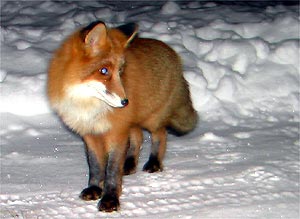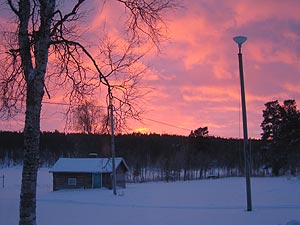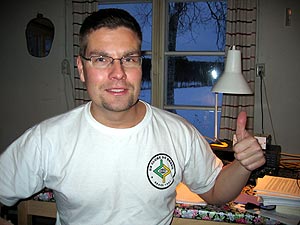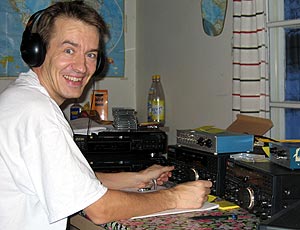|
LEM202 DXpedition Report
November 27 - December 4,
2004
Sheer adrenaline rushing through
our veins as we approached the beloved DXpedition
cottage in Lemmenjoki. October was heaven with sensational
catches from the Pacific, November was hell because
of a huge solar storm. What would it be like now in
Lemmenjoki? We would soon find out - I after a hiatus
of two years, Jim after a brief pause of two months.
Basic arrangements followed
the tradition of the previous years. On Friday evening,
November 26, I and Jim
Solatie met at the Helsinki railway station to
catch a train as far north as the tracks go to reduce
time spent driving on the road.

A young fox was curious
to make friends with DXers |
After arriving in Kolari on
Saturday morning, we drove up to Kittilä to shop
for groceries and then headed to the wilderness. As
we were approaching Lemmenjoki,
we met Hannu Asikainen and Hannu Niilekselä,
the outgoing pair of DXers, to exchange the latest
news about what's happening on the dial. The two Hannus
told us to expect Oregonians on graveyard frequencies,
and their prediction proved to be true.
Lemmenjoki was as
wintry as you can imagine this time of the year. Matching
the unexpectedly heavy snowfall around Helsinki, quite
a bit of fresh snow had fallen during the previous
week coating everything white. During our stay, the
temperature hovered mostly around -20 degrees Celsius
(-4 F), ranging from -30 to -10 Celsius (-22 to 14
F).
Some of the highlights
of the DXpedition had nothing to do with DXing. On
Sunday we were invited to celebrate our landlady's
85th birthday. Many guests wore traditional Saami
(Lappish) clothing, which are brightly colored just
like the aurora borealis (northern lights) at its
best. It was quite an experience to hear people singing
Lappish hymns, which of course we didn't understand
at all. We also had a close encounter with the Arctic
fauna. I spotted a young fox behind the window one
night at 2 a.m., the same one which Jim had seen on
one of his earlier DXpeditions.
Eventually DXpedition
LEM202 turned out pretty good. We had great conditions
towards Oregon and Washington, and although not much
was heard from anywhere else, that was enough. On
the negative side, both had flu, Jim on arrival, and
I later during the week. The cabin is Spartan in terms
of amenities, and if you're not feeling well, you
could use some additional comfort. One new type of
luxury was however introduced; Jim took along lunchboxes
from his favorite Thai restaurant. Extremely hot -
but it didn't bring about any conditions to Thailand.

Under the Arctic sky |
Propagation conditions followed
a fairly similar pattern on most days. In the afternoon
around 12-15 UTC the most common AM stations from
all around Asia would be audible, fighting with strong
Europeans. Without any clear focus, under these conditions
it was close to impossible to find any new stations
to identify. In general, Asia was quite a disappointment.
The best experience from this direction was Monday,
November 29, when we spotted more Chinese stations
than normally around 1215-1415 UTC.
Later in the evening we either reviewed tapes or slept,
as there was hardly anything interesting to listen
to - not even focused conditions to any particular
part of Europe. Only on Thursday, December 2, Australian
X-band stations made a brief appearance around 1730-1800
UTC. That was all we got from Australia and Oceania,
as the coveted island nations of the Pacific completely
eluded our ears. Maybe next time. This is however
the big new frontier at Lemmenjoki, where a new 1-kilometer-long
wire antenna, pointed at 30 degrees, was first erected
this season and proved to be remarkably successful
in October.

A deep-frozen Mika after
some antenna work at -25 degrees C |
During the night, the first
trans-Atlantic signals surfaced around 2100-2300 UTC.
They normally included CFFB Iqaluit NU (1230 kHz),
Harbour Light, Grenada (1400 kHz), and about a dozen
other common stations, including a bunch of Brazilians
in the upper end of the mediumwave dial. Nighttime
conditions however remained rather poor, with only
Brazilians occasionally coming well enough to warrant
hunting for new stations. Even later during the night
nothing much was heard from elsewhere in Latin America.
African stations were absent all the time, not even
South Africa was heard on 846 kHz, which is an empty
frequency every night. However, in the wee hours of
the morning 846 kHz did reveal Kalmykskaya GTRK, which
we had targeted for years.
The real thing began around 0500-0600 UTC, when trans-Atlantic
signals started to gain strength and Europeans began
to weaken. At this time conditions often favored Newfoundland,
US East Coast, the Great Lakes or the Rocky Mountains
for a very short period, before quickly moving on
to the West Coast, where the focus of the conditions
would remain for as long as any stations were audible.
On some days this morning session lasted for about
two hours, but on Wednesday, December 1, and Thursday,
December 2, stations from the northwestern corner
of the US remained audible until around 1400 UTC.

Jim Solatie (JMS) |
During the first hour or so
the conditions were often a bit surprising. For example
on December 2, there was a brief peak of stations
from New England. Jim took full advantage of this
by capturing in rapid succession WROW Albany NY (590
kHz) and WICC Bridgeport CT (600 kHz), probably the
best catches of the DXpedition. Though not as rare
a station, I was most happy about catching KOIT San
Francisco CA (1260 kHz), which happened to be my favorite
AM station when I lived in the Bay Area earlier this
year. It brought back some really nice memories.
Mexican stations were an added bonus. XEPE Tecate
BC (1700 kHz) was booming on most days, and other
stations were heard especially from Baja California
and Sinaloa.
The most common Alaskan and Hawaiian stations were
audible on most days, but nothing new for us aside
from KAGV Big Lake AK (1110 kHz), which was heard
with LSB test transmissions on a couple of days. The
signal strength was huge, so this is bound to become
a common station in northern Scandinavia once they
start operating regularly.
Tropical band frequencies sounded completely dead
most of the time. Signals began to improve towards
the end of the DXpedition, with some nice strong signals
on Saturday, December 4, our day of departure. Hopefully
our followers got more out of these.

Mika Mäkeläinen
(MTM) |
You can check out the LEM202
DXpedition log for a detailed list of what we
heard. Our equipment was the same as before, a collection
of JRC NRD-535 and NRD-545 receivers with a bunch
of amplifiers, preselectors, antenna splitters,
minidisc and cassette recorders. There were a total
of 18 longwire and beverage antennas, most of them
around 1000 meters in length. 15 antennas were pointed
to various parts of the Americas from southwest
(245 degrees) to north (355 degrees), and three
antennas (30, 55 and 85 degrees) were aimed at stations
to the East of us. Martti
Karimies had kindly provided us with three grounding
rods, and so we tried to hammer them into the frozen
ground to make the new 30-degree wire more resistant
to European interference. To no avail - I only managed
to brake an axe. Fortunately the axe head didn't
hit either one of us as it flew across the tundra...
| Date |
Solar flux |
Sunspot number |
Planetary A index |
Min-max solar wind
speed (km/sec) |
Number of flares
(events) |
| STAR |
SEC |
STAR |
SEC |
Daily low -
high |
C |
M |
X |
| 27.11.2004 |
110.3 |
57 |
64 |
10.0 |
10 |
6-15 |
366-438 |
2 |
|
|
| 28.11.2004 |
112.8 |
42 |
66 |
14.5 |
14 |
7-39 |
352-441 |
|
|
|
| 29.11.2004 |
111.4 |
50 |
40 |
15.1 |
15 |
12-22 |
422-580 |
2 |
|
|
| 30.11.2004 |
110.6 |
52 |
42 |
14.9 |
15 |
7-22 |
511-729 |
2 |
|
|
| 1.12.2004 |
111.0 |
51 |
52 |
12.8 |
13 |
4-48 |
506-705 |
5 |
1 |
|
| 2.12.2004 |
105.6 |
47 |
62 |
4.1 |
4 |
2-7 |
438-564 |
|
1 |
|
| 3.12.2004 |
100.8 |
39 |
58 |
3.3 |
3 |
2-4 |
368-451 |
|
|
|
| 4.12.2004 |
97.4 |
36 |
43 |
1.1 |
1 |
0-3 |
289-376 |
|
|
|
(information
collected by Jan Alvestad)
Space weather was favorable throughout
the DXpedition, with the solar flux hovering around
97-113, and A index from 1 to 17. Strangely, conditions
deteriorated towards the end of the week, altough
indices improved. Nevertheless, just as we departed
midday Saturday, the A index was almost zero and
Asian mediumwave stations were heard earlier than
on any previous day. This seemed to indicate good
conditions for the incoming DXers, Antti Aaltonen
and Timo Reiniluoto.
Published
on December 8, 2004
  
|